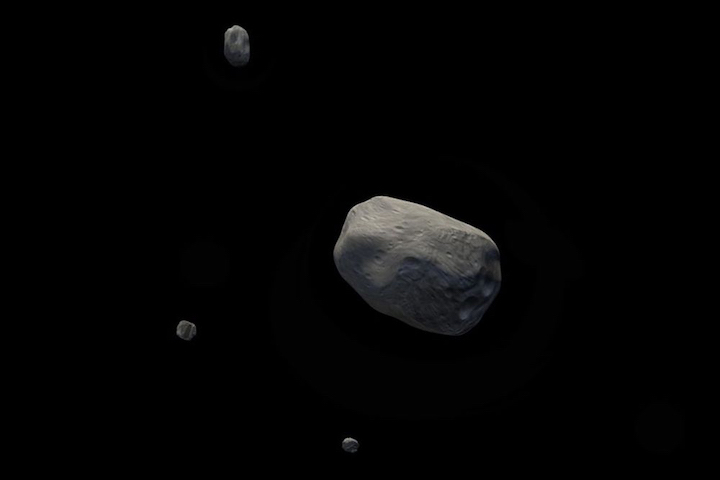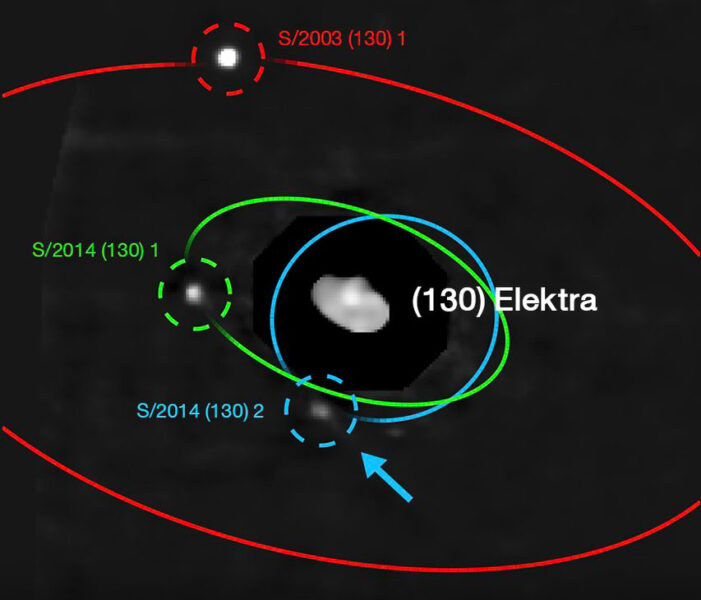10.03.2022

The discovery of the first quadruple asteroid system raises the question: Is there a limit to how many moons an asteroid can have?
Recently, astronomers found a third moon orbiting the asteroid 130 Elektra, breaking the record for moons among asteroid systems. The discovery of the first quadruple asteroid raises the question, just how many moons can an asteroid have? And where do these moons come from?
Anthony Berdeu (National Astronomical Research Institute of Thailand) and colleagues set out looking for asteroid moons when they delved into old observations taken by the Spectropolarimetric high-contrast exoplanet research facility (SPHERE), a set of instruments on the Very Large Telescope in Chile. Though primarily intended for picking out exoplanet fireflies next to their beacon-bright stars, SPHERE also shines when it comes to faint solar system objects. And researchers have previously used SPHERE to observe a second moon around Elektra, a main-belt asteroid with a composition similar to Ceres.
It was these observations that Berdeu’s team returned to in order to find the asteroid’s third moon, reported in Astronomy & Astrophysics. Hiding in the asteroid’s bright “halo,” the third object, designated S/2014 (130) 2, is the smallest of the bunch at 1.6 kilometers (1 mile) across (the other two are 6 km and 2 km, respectively).
Unfortunately, the moon appears on the same side of the asteroid in all the archival observations, which makes its orbit difficult to pin down. More observations would help with this. Additional data could also help astronomers narrow down the moon's composition.
Berdeu chose Elektra to test a new image-processing software he had developed, because he knew the asteroid already had two detected moons. The newest find thus happened by sheer luck and suggests that many-mooned asteroids might be a common phenomenon.

NARIT / A. Berdeu
But unlike Earth’s Moon, most asteroidal moons probably formed recently in the solar system’s history. Three main scenarios could happen in any given system: In gravitational capture, a passing rock passes too close to an asteroid and becomes part of its system. Or, if the asteroid spins quickly, it might fling off some rocks, which might either escape its weak surface gravity or ultimately remain part of the system as moons. Finally, moons might arise from debris ejected during an impact.
Because the newest moon appears to have an elongated orbit that’s inclined to the asteroid’s spin, the authors favor an impact scenario. But they really need to pin down the moon’s orbit and composition to make a solid case.
In theory, impacts could create quite a few moons, including much smaller ones than those we’ve detected so far. “Knowing that astronomers already discovered a satellite with rings, I would say that there is no fundamental limits of the number of moons you may find,” Berdeu says. “It is just that the more they are and the closer they are, and the less stable will be the system.”
Quelle: Sky&Telescope
